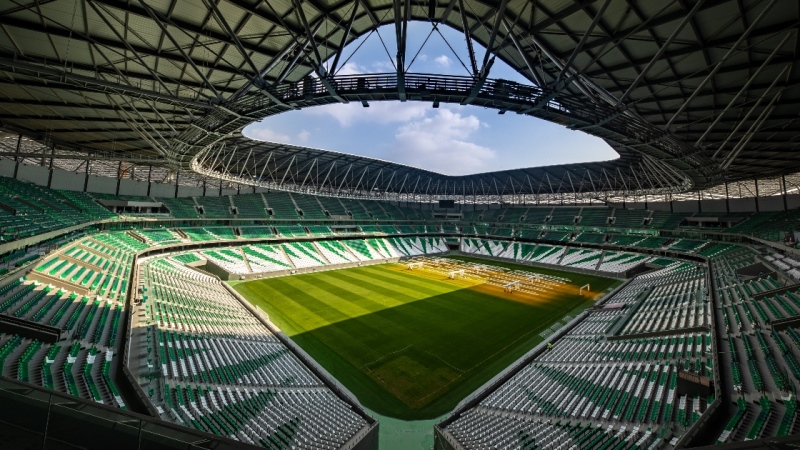
Mark Fenwick, co-founder of Fenwick Iribarren Architects,
Education City Stadium will provide an intoxicating atmosphere for both fans and players during the FIFA World Cup Qatar 2022. That’s the view of architect Mark Fenwick, who has been involved in the project from the very beginning.
It’s the third tournament venue to be unveiled by the Supreme Committee for Delivery & Legacy (SC) following the successful redevelopment of Khalifa International Stadium in 2017 and the inauguration of Al Janoub Stadium, in 2019.
Fenwick, co-founder of Fenwick Iribarren Architects, told www.qatar2022.qa that what marks this stadium out will be the proximity of fans to the pitch. He believes this will offer an intense and potent atmosphere in 2022.
During this interview, Fenwick, who is also involved in the development of two more stadiums, Al Thumama and Ras Abu Aboud, discusses the design process, Qatar’s unwavering commitment to sustainable solutions and why football stadiums carry emotional baggage – unlike almost any other building.

How did you get involved in the Education City Stadium project?
We entered a competition to design a stadium and surrounding sporting facilities for Qatar Foundation (QF). This was before Qatar had bid for the World Cup. Our original brief was to design a sports campus but this changed once Qatar won the bid. Our focus then became the football stadium.
During the bid process we actually supported Qatar during the presentations to FIFA. We were obviously delighted when Qatar won the bid and were happy to have played a tiny role in the success. We then worked closely with the SC, QF and FIFA on the stadium design.
I love the fact Qatar wants to host the best World Cup ever. Having all the stadiums in a small area means you can go to a couple of games a day. This is going to be totally unique – it’s almost an Olympics concept. The concept also includes the development of modern and technologically advanced stadiums, of which Education City Stadium will be a part.
What were your main architectural objectives in relation to the stadium?
We were also one of the first stadiums to really look at cooling. We worked with engineers to come up with a cooling solution, which was a big challenge. One solution is the shape of the stadium, which is the fruit of aerodynamics – it isn’t just nice looking, it also stops wind from getting into the venue. One of the great things about Qatar 2022 is that it’s helping to develop new, innovative systems such as cooling technology.

What’s the most exciting part of the architectural process?
For me, the most exciting part is when you sit down with a white piece of paper and a pencil. You start sketching and that’s exciting. Some ideas come slowly, while others come quickly. You think of the façade, the shape and people arriving. The beginning is always exciting.
The process is also exciting as you have many challenges and getting over those hurdles successfully is tremendously satisfying.
The final part is the opening game. I remember with RCDE Stadium in Espanyol, seeing it filled with 45,000 fans screaming and shouting, the players, the music – it was tremendously emotional. For me, the best bits are the very beginning and the final bit.
What’s amazing with a football stadium is that they have an emotional connection with people. This doesn’t happen with other buildings, such as shopping centres and offices. Football stadiums are so special – they generate so many emotions – and that makes them incredibly satisfying to work on.
What are your thoughts on the completed stadium and the effect it will have on the local community?
I think it’s a very special stadium. The main pillars of a healthy society are education and sport – and Education City Stadium symbolises both. Education takes care of the mind and sport takes care of the body. It was an essential part of the whole strategy and built into the project from the very beginning.
Legacy is also an important factor. Qatar has shown tremendous vision to deliver sustainable stadiums from a social and economic point of view. The country is showing a totally new vision to stadium architecture. This stadium will be used all year round. There will be classrooms and student facilities overlooking the pitch after the World Cup and that’s great.
I always think stadiums should give back to the community. They should not be aggressive buildings. This stadium will be the centre of the campus. It is very legacy friendly – unlike almost any similar construction in the world.
How proud will you feel when the stadium hosts World Cup matches?
I’m very much looking forward to the opening game. I’ve done the white piece of paper and pencil – now all I’m missing is the game and hopefully it will take place soon.
And of course, the World Cup itself will be amazing. To be working on three stadiums – I think it’s unique. I
think it’s the first hat-trick of the Qatar World Cup! A World Cup scenario will be fantastic. It won’t be a normal football match. It will be the peak of my career and I’m sure the whole tournament will be fantastic.





